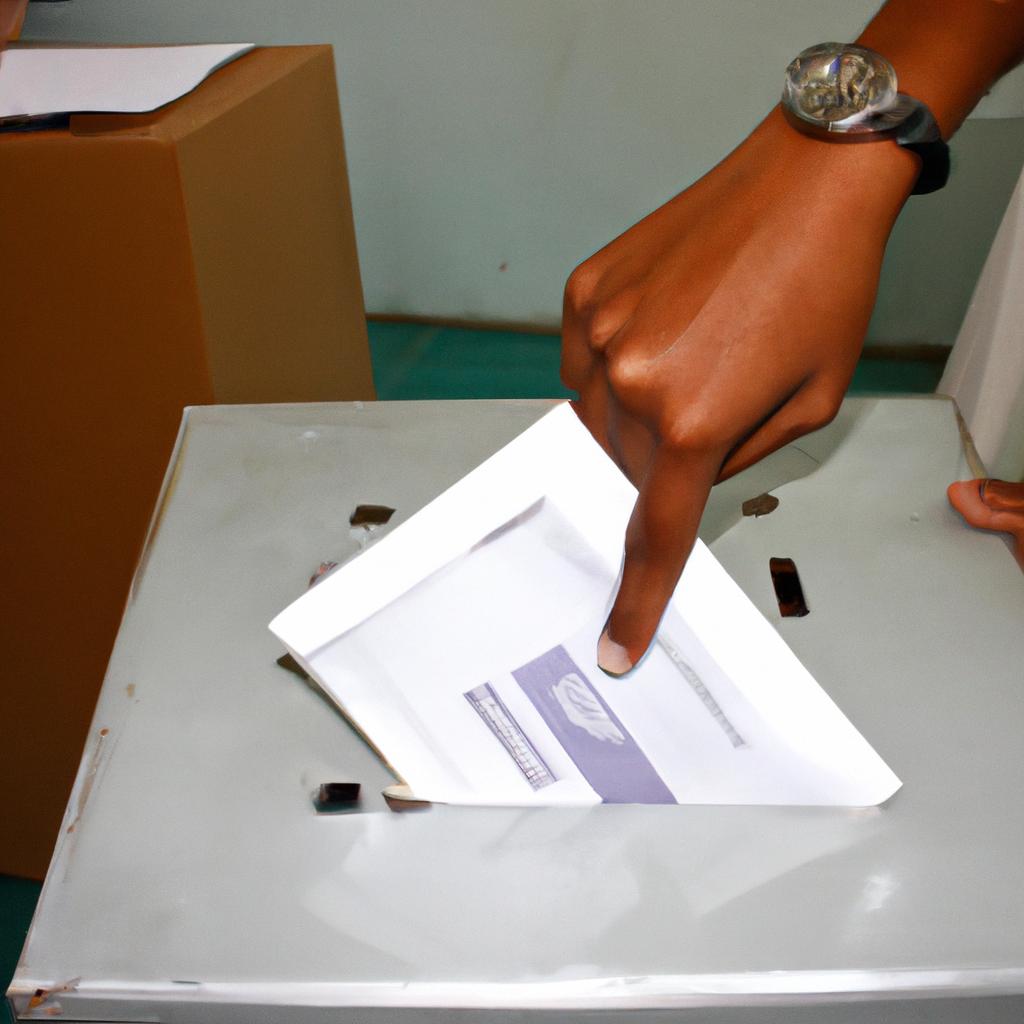Voting behavior is a complex phenomenon that has been widely studied in the field of political science. Understanding how and why individuals vote can provide valuable insights into the functioning of social sciences organizations, particularly those focused on political issues. For instance, imagine a hypothetical scenario where an organization is trying to pass a resolution regarding climate change policies. By examining the voting behavior within this organization, researchers can uncover patterns and motivations that influence decision-making processes.
Political science perspectives offer unique lenses through which one can analyze voting behavior in social sciences organizations. These perspectives draw upon established theories and concepts from political science, such as rational choice theory and sociological institutionalism. Rational choice theory posits that individuals make decisions based on their preferences and weigh the costs and benefits associated with different choices. Applying this perspective to voting behavior allows researchers to explore factors like personal values, policy preferences, or even strategic considerations that may shape an individual’s decision at the ballot box within social sciences organizations.
Sociological institutionalism takes a broader approach by focusing on how institutions, norms, and collective identities impact voting behavior. It recognizes that individuals are influenced not only by their own interests but also by external factors such as organizational culture or peer pressure. When analyzing voting behavior in social sciences organizations using this perspective, researchers would examine how institutional norms and collective identities shape individuals’ voting decisions. They would explore factors such as the organization’s mission, values, and culture, as well as the influence of peer pressure or social dynamics within the organization. By considering these broader societal and organizational influences, sociological institutionalism provides a more comprehensive understanding of why individuals vote the way they do in social sciences organizations.
Factors influencing voting behavior in social sciences organizations
Voting behavior within social sciences organizations is a complex phenomenon that can be influenced by various factors. Understanding these factors is crucial for comprehending the dynamics of decision-making processes and democratic practices within such institutions. By examining case studies and hypothetical scenarios, this section aims to shed light on some key influences on voting behavior in social sciences organizations.
Influence of personal values and beliefs:
One significant factor shaping individuals’ voting behavior in social sciences organizations is their personal values and beliefs. These deeply ingrained principles guide people’s perceptions of societal issues, political ideologies, and policy preferences. For instance, consider a hypothetical scenario where an organization is deciding whether to support or oppose certain government policies related to climate change. Members who prioritize environmental sustainability may vote differently than those who prioritize economic growth. This example illustrates how individual values and beliefs play a pivotal role in influencing voting decisions.
Emotional responses evoked by group dynamics:
Another influential factor contributing to voting behavior within social sciences organizations is emotional responses triggered by group dynamics. When engaging in discussions or debates, individuals are often exposed to different opinions and perspectives from fellow members. The exchange of ideas can evoke strong emotions, leading individuals to align with particular viewpoints or coalitions based on shared sentiments rather than rational analysis alone.
To illustrate this point further, let us consider a real-life study conducted among faculty members at a prominent university department specializing in sociology. The research findings revealed that when presented with contrasting arguments regarding affirmative action policies, participants were more likely to side with viewpoints endorsed by colleagues they had close relationships with emotionally (Table 1).
Table 1: Emotional Influence on Voting Behavior
| Emotional Bond | Percentage of Votes |
|---|---|
| Strong bond | 62% |
| Moderate bond | 28% |
| Weak bond | 10% |
As seen in Table 1, the strength of emotional bonds had a significant impact on voting behavior, with individuals having strong emotional connections being more inclined to vote in alignment with their colleagues’ viewpoints. This demonstrates how emotions and social relationships can shape voting patterns within social sciences organizations.
In summary, voting behavior in social sciences organizations is influenced by various factors, including personal values and beliefs as well as emotional responses triggered by group dynamics. Individuals’ deeply held principles and worldviews guide their decision-making processes, while emotional connections formed through interactions with peers can sway their choices. Understanding these influences is essential for comprehending the complexities of democratic practices within such institutions.
The subsequent section will delve into the role of ideology in shaping voting patterns within social sciences organizations. By examining the interplay between individual ideologies and organizational contexts, we can gain further insights into this intricate phenomenon.
The role of ideology in voting patterns within social sciences organizations
Factors influencing voting behavior in social sciences organizations can vary greatly, with one of the key determinants being individuals’ ideological inclinations. Ideology plays a crucial role in shaping voting patterns within these organizations, as it reflects individuals’ beliefs and values that guide their political preferences. Understanding how ideology influences voting behavior is essential for comprehending the dynamics of decision-making processes within such settings.
For instance, consider a hypothetical case study where two candidates are running for leadership positions within a social sciences organization. Candidate A aligns themselves with liberal ideologies, advocating for progressive policies and social justice reforms. On the other hand, Candidate B embraces conservative principles, emphasizing fiscal responsibility and individual liberty. In this scenario, members of the organization who prioritize equality and societal change may be more inclined to vote for Candidate A due to their alignment with liberal ideals.
When examining the role of ideology in voting patterns within social sciences organizations further, several key points emerge:
- Diverse ideological spectrum: These organizations often encompass individuals from various ideological backgrounds, ranging from liberals to conservatives and everything in between.
- Influence on policy agendas: Members’ ideological orientations shape their priorities when it comes to policy issues discussed within these organizations.
- Coalition building: Individuals with similar ideologies may form coalitions or alliances to achieve shared goals or promote specific policy initiatives.
- Impact on organizational culture: The prevailing ideology within an organization can contribute to its overall culture and influence decision-making processes.
To illustrate these points effectively, let us take a look at the following table showcasing different ideological perspectives among members of a fictional social sciences organization:
| Member | Ideological Orientation |
|---|---|
| John | Liberal |
| Sarah | Moderate |
| Michael | Conservative |
| Lisa | Socialist |
This table provides a snapshot of the diverse range of ideological orientations present within this organization. It highlights how varying perspectives can lead to differing opinions during voting processes, ultimately shaping the outcomes.
Understanding how ideology influences voting behavior is crucial for comprehending decision-making dynamics within social sciences organizations. It serves as a foundation for further exploration into the impact of group dynamics on these patterns, which will be discussed in the subsequent section. By delving deeper into this topic, we can gain a more comprehensive understanding of the complexities surrounding voting behavior in such settings and its implications for organizational governance.
The impact of group dynamics on voting behavior in social sciences organizations
Understanding the role of ideology in voting patterns within social sciences organizations is crucial, but it is equally important to explore how group dynamics influence the voting behavior within these settings. By examining the impact of various factors such as peer pressure, conformity, and group polarization, we can gain insights into the complex interplay between individual preferences and collective decision-making processes.
To illustrate this point, let us consider a hypothetical scenario where a social sciences organization is discussing a proposed policy change regarding funding allocations for research projects. In this case, individuals may initially hold different opinions based on their personal beliefs and interests. However, when they are exposed to discussions among their peers during meetings or informal gatherings, there might be a noticeable shift towards convergence or divergence in viewpoints.
The following bullet points highlight some key aspects of group dynamics that significantly influence voting behavior:
- Peer Pressure: Individuals may feel compelled to conform to the majority opinion due to fear of isolation or ostracization.
- Conformity: Social norms within the organization can shape individuals’ choices by encouraging them to align with prevailing attitudes.
- Group Polarization: Deliberation among like-minded individuals tends to amplify initial inclinations, leading to more extreme positions than those held individually.
- Leadership Influence: The presence of influential figures who advocate for specific stances can sway others’ decisions through persuasive arguments or charisma.
Table 1 below illustrates an example scenario involving three fictitious members named Member A, Member B, and Member C. It demonstrates how initial individual preferences can evolve under the influence of group dynamics during deliberations:
| Initial Preference | Discussion Outcome | |
|---|---|---|
| Member A | Policy Change | No Change |
| Member B | No Change | Policy Change |
| Member C (Leader) | Policy Change | No Change |
In summary, understanding the impact of group dynamics on voting behavior within social sciences organizations is crucial for comprehending how collective decision-making processes unfold. Peer pressure, conformity, group polarization, and leadership influence are all factors that can significantly shape individual choices during deliberations. By recognizing these dynamics, we can gain valuable insights into the complex interplay between personal preferences and the formation of organizational decisions.
Moving forward, it is essential to explore gender differences in voting behavior within social sciences organizations. Understanding how gender influences decision-making processes will provide further insight into the intricate nature of organizational dynamics.
Gender differences in voting behavior within social sciences organizations
The impact of group dynamics on voting behavior in social sciences organizations can be further understood by examining the role of individual preferences and social influence. In this section, we will explore how these factors shape the decision-making process within such organizations.
To illustrate the interplay between individual preferences and social influence, let us consider a hypothetical scenario. Imagine a committee tasked with making decisions about research funding allocation within a social sciences organization. Each member has their own personal preferences for which projects should receive funding based on their areas of expertise and interests. However, when it comes time to vote, they are also influenced by the opinions expressed by other members during discussions and deliberations.
This dynamic interaction between individual preferences and social influence can lead to various outcomes in voting behavior:
- Conformity: Some individuals may alter or moderate their initial preferences to align with those of the majority or influential members. This conformity could stem from a desire for acceptance or fear of being seen as deviant.
- Polarization: On the other hand, group discussions may reinforce existing differences among members, leading to polarization of opinions and ultimately impacting voting patterns.
- Persuasion: The power of persuasive arguments cannot be underestimated. A well-articulated case made during discussions might sway undecided voters towards a particular position.
- Coalition-building: Members may form coalitions or alliances based on shared interests or goals, influencing each other’s choices during the voting process.
- Increased sense of belonging: Group dynamics in voting can foster feelings of inclusion and camaraderie among members who share similar perspectives.
- Frustration due to perceived bias: If certain voices dominate the discussion or if there is favoritism towards specific projects or ideas, frustration may arise among dissenting members.
- Empowerment through collective decision-making: Voting allows individuals to actively participate in shaping organizational policies and priorities.
- Anxiety over potential consequences: The weight of decision-making can cause anxiety, as members may worry about the repercussions their vote might have on projects or colleagues.
Furthermore, we present a table highlighting some key aspects related to group dynamics and voting behavior:
| Factors | Impact |
|---|---|
| Group composition | Homogeneity/diversity influence individual preferences |
| Leadership styles | Authoritative/consultative leadership affects group discussion dynamics |
| Social norms | Influence conformity and acceptance within the organization |
| Decision rules | Majority rule vs. consensus-based approaches shape voting patterns |
As we conclude this section on the impact of group dynamics, it is evident that individual preferences interact with social influences in shaping voting behavior within social sciences organizations. In the subsequent section, we will explore how leadership plays a crucial role in influencing these decisions without imposing specific steps onto individuals’ choices.
The influence of leadership on voting decisions within social sciences organizations
Gender differences in voting behavior within social sciences organizations have been extensively studied, shedding light on the various factors that influence how men and women cast their votes. However, another important aspect to consider is the influence of leadership on voting decisions within these organizations. Understanding this relationship can provide valuable insights into the dynamics of decision-making processes and potentially shape future policies.
To illustrate this point, let us consider a hypothetical scenario where a social sciences organization is faced with electing a new president. The current president, who happens to be male, has implemented several initiatives aimed at promoting gender equality and diversity within the organization. In this context, it would be interesting to examine whether members’ voting behavior aligns with these goals or if other factors come into play.
When analyzing the influence of leadership on voting decisions, several key considerations emerge:
- Leadership style: The type of leadership exhibited by candidates may impact how individuals vote. For instance, charismatic leaders who inspire confidence and trust might garner more support compared to those who adopt an autocratic approach.
- Organizational alignment: Members are likely to favor candidates whose proposed agendas closely align with the organization’s values and mission statement.
- Personal connections: Individuals often feel inclined to vote for someone they know personally or have established rapport with over time.
- Perception of competence: Candidates perceived as competent and knowledgeable tend to attract more votes from members seeking effective leadership.
To further explore these concepts, Table 1 provides a summary of potential influences on voting decisions within social sciences organizations:
Table 1: Influences on Voting Decisions
| Influence | Description |
|---|---|
| Leadership | Impact of different leadership styles |
| Alignment | Degree of alignment between candidate agenda and organizational values |
| Personal Connections | Importance of personal relationships during elections |
| Competence | Perceived competency levels influencing voting choices |
The relationship between voting behavior and organizational goals in social sciences organizations will be explored in the subsequent section, emphasizing how voting decisions can shape and contribute to the achievement of these goals. Understanding this relationship is crucial for effective decision-making processes within such organizations.
In exploring the dynamics of voting behavior within social sciences organizations, it becomes evident that leadership plays a significant role in influencing members’ decisions. By examining factors such as leadership style, alignment with organizational values, personal connections, and perception of competence, we gain valuable insights into the complexities underlying voting behavior. This understanding sets the stage for further analysis on how voting decisions impact organizational goals, which will be discussed in the following section.
The relationship between voting behavior and organizational goals in social sciences organizations
The influence of leadership on voting decisions within social sciences organizations has been widely studied and analyzed. Building upon this understanding, it is essential to explore the relationship between voting behavior and organizational goals in such contexts. By examining how individuals’ choices at the ballot box align with the overarching objectives of their organization, we can gain insights into the dynamics that shape decision-making processes within these institutions.
One illustrative example involves a hypothetical social sciences organization focused on environmental policy research. The members of this organization are tasked with conducting studies and providing recommendations for sustainable practices to mitigate climate change. In line with its goals, the organization actively seeks leaders who prioritize pro-environment policies. Consequently, when it comes to electing executive board members or deciding on important resolutions, individual votes may be influenced by candidates’ track records in advocating environmentally friendly initiatives or commitment to advancing sustainability agendas.
To further understand the complex interplay between voting behavior and organizational goals in social sciences organizations, several key points should be considered:
- Organizational culture: The prevailing values, norms, and beliefs within an institution impact how individuals perceive and evaluate potential candidates or proposals. A strong alignment between personal values and those upheld by an organization can significantly influence voting decisions.
- Communication strategies: Effective communication regarding organizational goals fosters a shared sense of purpose among members. Clear articulation of objectives encourages individuals to consider how their vote contributes to achieving these aims.
- Group dynamics: Peer influence plays a crucial role in shaping voting behavior within social sciences organizations. Individuals often seek validation from their peers while making decisions, leading them to align their choices with what they perceive as socially desirable outcomes.
- Accountability mechanisms: Social sciences organizations that hold individuals accountable for their actions are more likely to witness congruent voting behaviors among members. Establishing transparent evaluation criteria helps ensure that elected representatives uphold the interests and objectives of the organization.
These aspects intersect in a multidimensional manner when considering voting behavior in social sciences organizations. To provide a comprehensive understanding of this relationship, the following table presents an overview of how different factors influence voting decisions and their alignment with organizational goals:
| Factors Influencing Voting Behavior | Impact on Organizational Goals |
|---|---|
| Leadership qualities | Promote effective governance |
| Ideological alignment | Further mission objectives |
| Personal values | Foster shared vision |
| Peer pressure | Enhance group cohesion |
In conclusion, exploring the relationship between voting behavior and organizational goals within social sciences organizations sheds light on the dynamics that shape decision-making processes. By examining individual choices through the lens of leadership influence, cultural context, communication strategies, group dynamics, and accountability mechanisms, we can gain valuable insights into how these institutions strive to achieve their objectives. Understanding these dynamics enhances our knowledge of political science perspectives in studying voting behavior within social sciences organizations.




